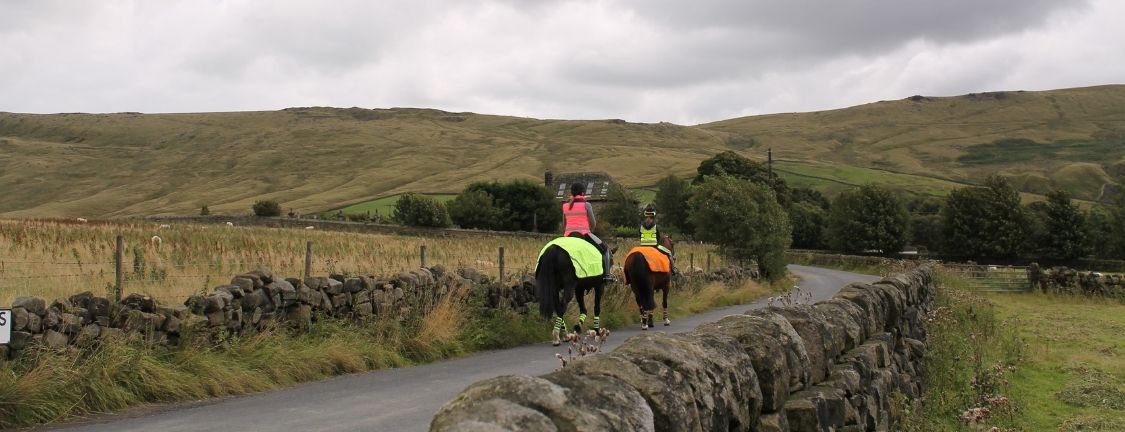
Dealing with a road accident while horse riding
Whether you’re riding on the main road or a country lane, horses and their riders are amongst the most vulnerable road users. Anything from a vehicle blowing its horn to a pheasant dashing out across the road can spook a horse and cause an accident or rider to fall. It is estimated there is a traffic incident involving a horse rider on the roads every day in Britain with 84% of these incidents being caused because of a driver passed the horse and rider too closely.
So what can you do if you’re involved in a horse riding road traffic accident?
In any emergency situation, run through the ‘ABC’ checklist to ensure you do everything in the right order and in the casualty’s best interests.
- Assess for danger: For example the risk of a loose horse trampling the casualty; this loose horse will need to be secured or held by a passer-by or fellow rider before the injured rider can be checked. If a horse has gone home don’t run after it until you have checked the rider is OK. Any nearby traffic will need to be stopped. Managing these dangers on the roads are challenging following a riding accident but are important to both protect yourself and the injured rider.
- Alert Response: Talk to the injured rider. Place your hands on their shoulders and gently apply pressure to assess if they are responsive or unconscious. If they are conscious talk to them and keep them calm and check for other injuries. If the rider is unconscious, then check their airway.
- Airway and breathing: Ensure their away is not blocked. Tilting the head and lifting the chin will move the tongue away from their airway. Look and listen to see if the casualty is breathing.
- CPR: If the casualty is unconscious and not breathing effectively, phone 999 and begin CPR.
- Keep the casualty still : Anyone with a suspected neck or back injury should be kept still – movement can cause more damage. It’s OK to leave someone on their back if they are conscious, as they can tell you if they’re going to be sick. But aim to minimise movement until help arrives by immobilising the head. Place your hands on either side of the head and keep talking to them, to reassure them and encourage them to stay still.
- Control blood loss: If the casualty is bleeding. control the blood loss by applying pressure, clean the wound and apply a bandage. Monitor the colour, sensation and movement of a wounded limb.
- If the casualty is unconscious place them in the recovery position , ensuring that their airway is open and draining. Be alert for vomit and ensure it drains away.
- Call 999/111 and ask for an ambulance giving them details of the location and what’s happened and the condition of the injured rider. Use a grid reference or What3Words to give a more accurate location
- Report road incidents. An incident is any unplanned event that has resulted in a human or horse feeling unsafe (e.g. road rage), the potential to cause injury to horse and human even though it may not have at this time (a near-miss) already caused injury to human or horse (an accident)
It is important to recognise everyday riding can result in all sorts of dramas which makes it so important for riders and horse owners – and friends and relatives of riders – to be trained in first aid so they can help in the event of an incident.

Here are some tips to help you stay safe on the road:
- Wear high viz clothing or gilet, preferably with ‘slow down for horses’ or another useful slogan on it and remember you can never wear too much.
- Plan your route carefully – is it suitable? Are there safe zones you can retreat to? Be aware of the blind spots and popular overtaking areas where cars might appear without seeing you.
- Ensure all riders with you know what to do in the event of an incident.
- If you’re riding on your own, enable SafeRide through the Harry Hall Riding App. It will alert your nominated contact should you have a fall while out riding.
- Use clear hand signals if you’re wanting cars to pass you and when you are turning or moving across a lane or roundabout.
- Make sure you thank considerate drivers with a wave and a smile, it will encourage them to pass other horse riders in the same fashion. Carry a first aid kit in individual bum bags or larger ones for the lead rider. Get trained in first aid too!
- Don’t use actively use your phone when riding – it’s illegal, unsafe and only provokes anti-rider attitudes. T
- Follow the same good practice when on a cycle track or countryside trail with regards to cyclists.
- Be aware of the access rights of riding in the country you are in. This varies throughout the UK.
- If you’re not sure about riding and the UK highway code , find out before you put yourself and your horse at risk.
About First Aid Training Co-operative and Medi-K
They work together to run highly respected equestrian specific first aid courses. Cory has been running first aid courses for outdoor workers for over 20 years and along with the training team at Medi-K, Cory has developed an equestrian first aid manual that can be downloaded to your phone or tablet.
